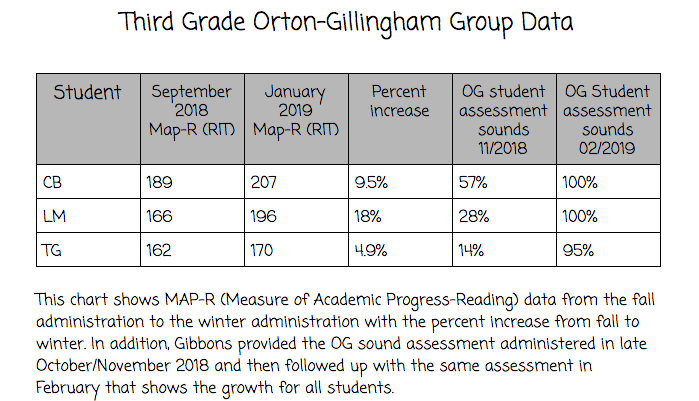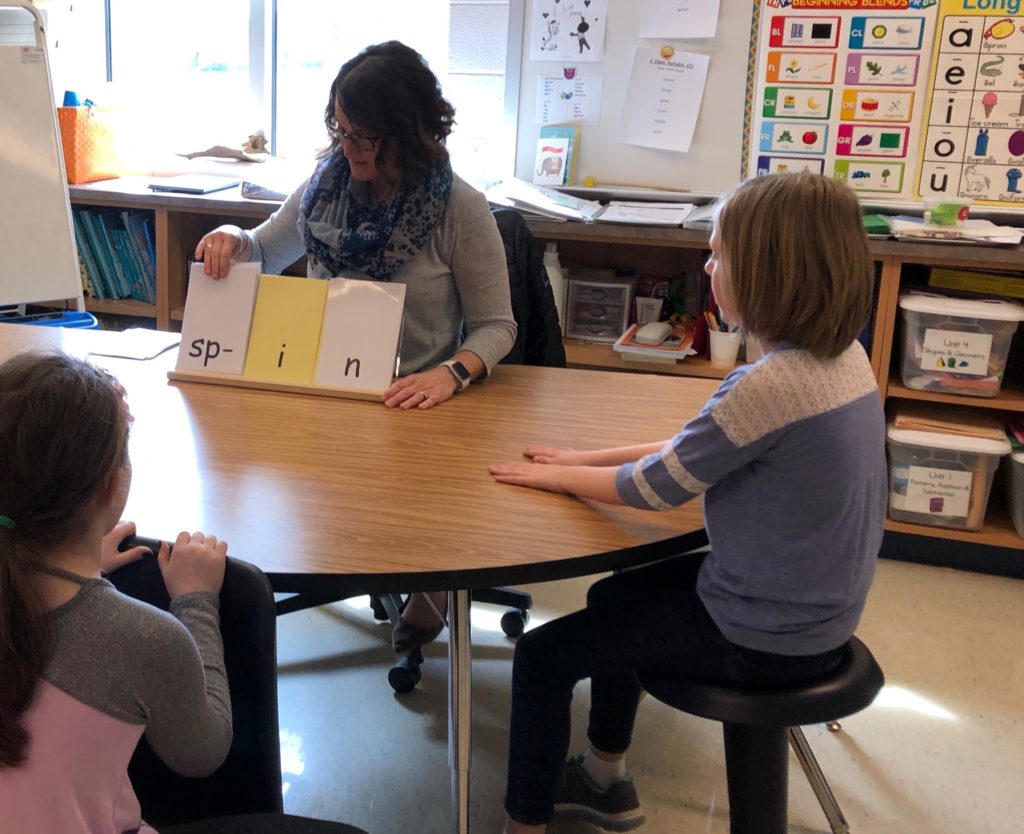
Laurie Gibbons teaches OG lessons at Darnestown Elementary School.
Gibbons is a special education resource teacher at Darnestown Elementary School in Montgomery County, Maryland, a suburb of Washington, D.C. The K-5 school has just under 300 students and an average class size of 20-25 kids. About a quarter of students are minorities.
For Gibbons, who is in her 20th year of teaching, IMSE’s Orton-Gillingham was a game-changer.
The teaching strategy is a structured approach that breaks down reading and spelling into smaller skills involving letters and sounds, and then builds on those skills over time. Educators use sight, hearing, touch and movement to help students connect with concepts.
After completing Orton-Gillingham training with the Institute for Multi-Sensory Education in November, Gibbons assessed three third graders’ abilities to grasp vowel and consonant sounds. The kids were able to identify 57, 28 and 14 percent of what they heard, respectively.
After just three months of incorporating IMSE’s approach, those same students’ identification abilities jumped to 100, 100 and 95 percent.
“I was amazed how quickly the kids responded to the instruction,” Gibbons said.
She worked with the small group — two special education students and one general education — three or four times per week, starting with three-part drills and vowel-intensive lessons to “fill in the gaps.”

“I sort of ditched what I did before and hit the ground running,” Gibbons said. “It’s just been amazing to see the way that they embraced the program using the multi-sensory approach. I was thinking: I don’t know if these third graders will want to write in sand. But they LOVE it.”
Gibbons specializes in reading and math intervention at Darnestown Elementary. She helps teachers with assessments and lesson planning, and currently works with small groups of kindergarten, first and third graders. She also co-teaches fourth-grade math.
“I’m considering going back into the classroom so that I can provide this to a whole classroom full of kids because it works.”
IMSE’s Orton-Gillingham has been a success at each grade level — something Gibbons attributes to fun and straightforward lessons. “Attacking” words in syllable division is a current favorite.
“The students are enthusiastic about the multi-sensory approach, the quickness of the drills,” Gibbons said. “The kids also really remember the rules and the way they’re described. … You just give them the truth. You don’t sugarcoat it, you don’t give it a fancy name. It’s just: These are beginning blends. That’s what they are.”
https://twitter.com/lkgibbons/status/1100797639648522242
Gibbons said she’s not only seeing success at school — but also at home, where her youngest of three children is a “guinea pig” during lesson planning.
“I’ll do my kindergarten lessons with her at home, and she, too, is so eager to learn the next letter and the next sound,” Gibbons said.
The veteran teacher, who dabbled with multi-sensory lessons before officially completing IMSE’s OG training, said she’s been so thrilled about the results that she’s considering going back to classroom teaching. Gibbons previously taught first, third and fifth grade before transitioning to special education nine years ago.
“Taking this training has really made me think: How can I use this to reach more students?” Gibbons said. “How can I get more bang for my buck? How can I spread the word?. … I’m considering going back into the classroom so that I can provide this to a whole classroom full of kids because it works.”

Laurie Gibbons teaches OG lessons at Darnestown Elementary School in Maryland.
IMSE believes that all children should be able to read. To achieve this end, IMSE wants to bring Orton-Gillingham to all educators to give children the best literacy instruction possible.
Learn more about what you can do to improve literacy for all using the Institute for Multi-Sensory Education’s Orton-Gillingham training.
Please connect with us on Facebook, Twitter, and Pinterest to get tips and tricks from your peers and us. Read the IMSE Journal to hear success stories from other schools and districts, and be sure to read the OG Weekly email series for refreshers and tips.
